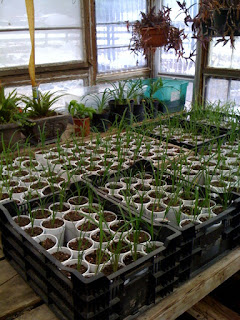This is a crowd pleaser. It's a dish I've taken to many different families - all of whom
rave over it. Busy moms you're gonna love it, too!
If you're tempted to eat out a lot, add this simple recipe to your regimen and you'll be glad you did! The first recipe is way better for you than
any fast food.
There are a variety of ways to make red beans and rice. I'll start with the simplest then tell you how to make it more nourishing.
The original recipe came from a slow cooker Southern Living cookbook:
16 oz smoked sausage (nitrate-free), sliced
2 (10oz cans) Rotel
3 1/2 cups MSG-free broth, preferably
homemade
2 t creole seasoning, or
make your own
1 1/2 c. uncooked brown rice
2 (15 oz. cans) red beans, rinsed and drained
Place all ingredients in slow cooker. Cover and cook on low for 4 hours.
Comments:
Making it according to the directions above was too spicy for my family. You can replace the 20oz of Rotel with a 28oz can of diced tomatoes and it's just as tasty.
Cajun seasoning can be found in the bulk spice section at Whole Foods. I also found
creole seasoning (MSG-free) at Drug Emporium. I *think* you can interchange cajun for creole seasoning.
To kick it up a nourishing notch or two:
- this version makes
more and is
frugal with dried beans.
Soak 1 pound (2 generous cups) of dried red beans overnight in a large bowl of warm water.
In another container, soak overnight 1.5 cups uncooked brown rice in rice water.
Read here how and why to soak rice in rice water. Soaking rice is not essential but doing so allows the nutrients in the rice to become better absorbed in the body.
In the morning, drain beans then place them in a large crock pot with 6 cups of broth. Cook on high 4 hours.
Then add:
1
chopped onion
3-4 stalks of celery, chopped
4 cloves garlic, minced
1 jalapeno, minced (optional)
1 1/2 cup uncooked,
soaked then drained, brown rice
28 to 32 oz diced tomatoes
1/2 to 2 teaspoons of
creole or cajun seasoning - to taste
1/2 to 2 teaspoons of Real Salt
14oz nitrate and MSG-free sausage, sliced
Cook on high for 3-4
more hours. If you are tempted to peek and stir, it takes longer to cook. Don't ask me how I know.
Optional garnish before serving:
- chopped red or green bell pepper
- chopped green onion
- chopped parsley
Comments:
- The organic celery at Kroger was only $0.30 more than the pesticide laden conventional celery.
Celery is on the dirty dozen and in my mind worth the extra $0.30!
- I used a jalapeno because I knew I didn't have enough creole seasoning to make the dish spicy. And because I had an extra jalapeno in my fridge.
- My mom gave me several jars of her canned tomatoes in 32 oz jars. When I'm out of her tomatoes, I use 28 oz cans from the grocery store.
- If you're using store bought broth, you won't need as much salt. I used
homemade (unsalted) broth so this recipe needed a lot of salt.
- I bought smoked sausage from Whole
Paycheck Foods; my husband is highly sensitive to MSG. After taking the below picture I realized Youngblood Grassfed Farms
sells smoked sausage through ASN. EDIT: I bought some from Youngbloods and it was great - will buy more from them again. EDIT AGAIN: Also tried using brats from Cove Creek Acres and they too work!
I slice the sausage very thin so that it seems like there is more meat in the dish. If your family likes a lot of meat, and you're making the recipe with a pound of beans, I would get two sausages. By far, the sausage is the most expensive ingredient in this dish. (It is still a tasty dish if you omit the sausage.) If using two sausages, I would saute the sausage separately and add it at the very end - as my crock pot was very full.
-
Parsley is excellent in aiding digestion. And, if you've planted some in central Arkansas, it will live through the winter.
- I cooked the beans separately for the first four hours so they would get tender, faster. I've tried dumping all the ingredients together and it seemed to take FOREVER for the beans and rice to cook, since my crock was so full. If anyone tries this recipe and puts everything in the crock at once and it works for you - let me know.
Also linked to
Real Food Wednesday.
-Julie






























